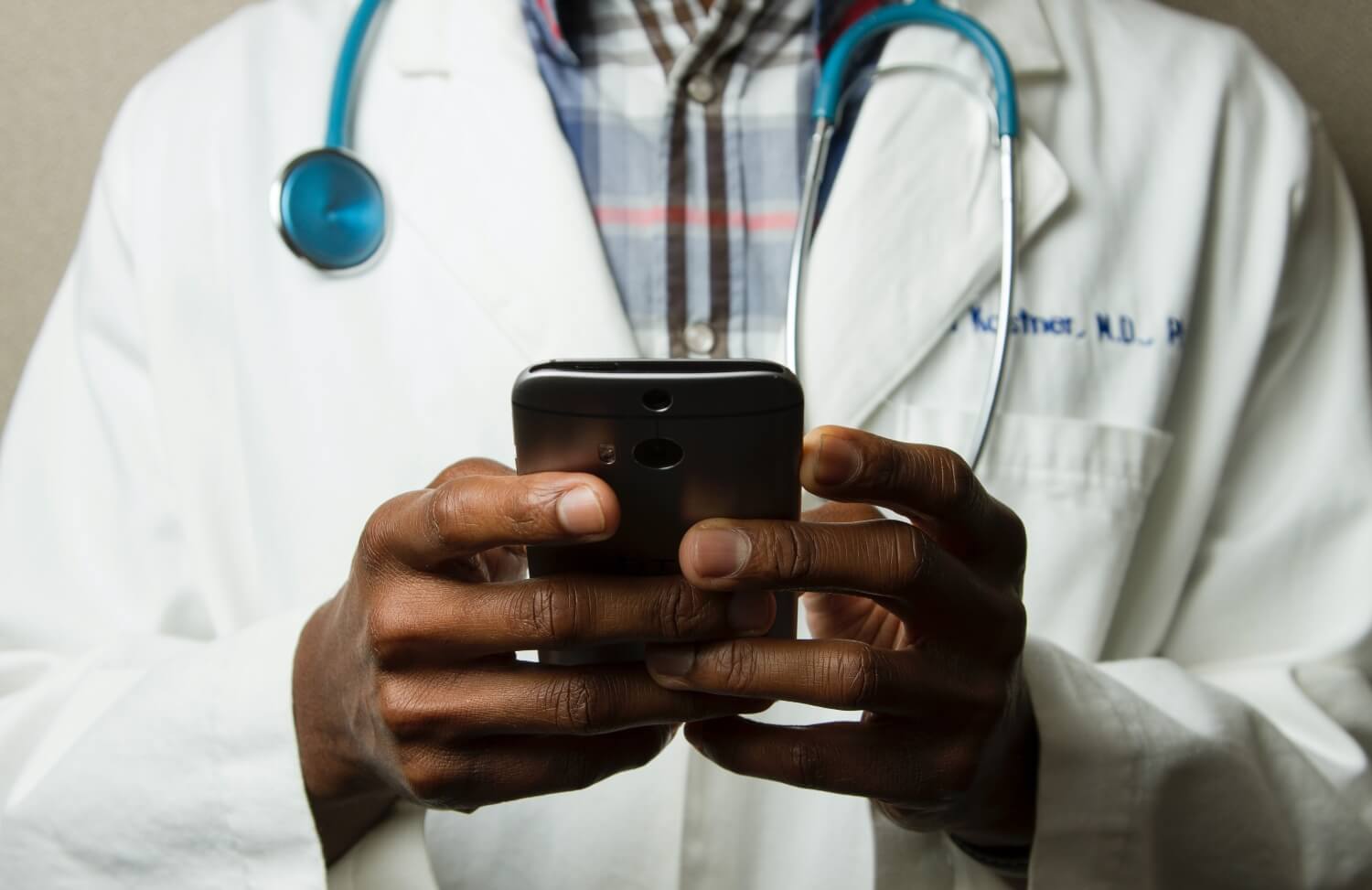От халепа... Ця сторінка ще не має українського перекладу, але ми вже над цим працюємо!

Healthcare software development: A how-to guide for telehealth

Supernerd
/
Developer
9 min read
Article contents:
Introduction
It’s just incredible how much we’ve all heard about digital transformation in the last two years, and even industries with strong regulations are going digital. One of those industries is healthcare.
Of course, healthcare software development did exist before 2020, but its quantum leap since 2020, in terms of both evolution and demand, is astonishing.
Now that the world as we knew it has changed, healthcare IT solutions are embracing the change even more. Some reports predict the global telehealth market to grow to over $636 billion (USD) by 2028.
Yes, the digital healthcare market is blossoming. However, it doesn’t mean that any healthcare solution will succeed in the market. Like other industries, this sector has key definitions, technologies, and processes that lead to success. Or failure. In this article, we discuss what makes a digital healthcare product a success.

Telehealth: The fundamentals
Let’s first address the basics.
By its classic definition, telehealth refers to remote healthcare services using electronic and telecommunication technologies without a patient’s in-person presence in a doctor’s office.
There currently exist four telehealth modalities:
Synchronous technology (live video conferencing) enables diagnosing and providing healthcare services via video communication software solutions. For the last 2 years, it’s become more popular for the general population, although earlier, it was mainly used for rural inhabitants, military personnel, and inmates. This method usually relies on high-resolution cameras and video scopes (a special camera given to chronic patients).
Asynchronous telehealth (store-and-forward) facilitates care delivery in two-ways collecting, storing, and transferring patient data, including X-rays, photos, videos, and text descriptions, between a patient and a doctor for further condition assessment and treatment.
Remote patient monitoring (RPM) is a real-time data transmission that allows patients to use specialized devices to collect and transmit their vital signs to healthcare providers for evaluation. For example, this technology might help doctors monitor seniors’ vital signs, like blood pressure or cardiac stats.
Mobile health (mHealth) is a broad term that incorporates several telehealth devices. Basically, it refers to a one-way communication that allows patients to use mobile devices like smartphones, wearables, and tablets for care delivery and improvement from doctors. These healthcare software solutions enable patients to track their vitals, send them to healthcare providers, set appointments instantly, and conduct communication with them via live chats or video calls.
See also: We are recognized as top software developers by TopDevelopers.co.

The fundamentals of building telehealth solutions
So, what does it take to create a healthcare software product? Let’s examine this in detail.
Use a 360-degree perspective
As you already know, digital healthcare development is not just about implementing technology for technology’s sake. Its primary goal is to help all parties at every stage of the doctor-patient relationship and care delivery process.
Make it patient-centered. At the investigation stage, you conduct competitive research on how other healthcare solutions interact with patients. But that’s not quite enough. Developers start with ideation to conduct research through focus groups to clearly identify a pain point and brainstorm about how to address it. Then, they test their future product with non-patients in the early stages of development, proceeding with patients-to-be. They start with A/B testing of the design and follow-up surveys asking users about what improvements they’d like to see, nice-to-have features, preferable devices, and transparency of user workflows. Developers’ research is as thorough as possible to ensure that your target users have a smooth and functional UX.
Keep healthcare professionals in mind. Although healthcare apps and solutions are focused primarily on people who need healthcare assistance, developers without a doubt also consider those who provide this assistance: healthcare specialists. Developers consider providers’ convenience and comfort and think about providers’ pain points and needs. They’ll ask for feedback from unbiased professionals in the specialty for which they’re developing the solution. Providing doctors with training and educational programs on new technologies would be a good decision.
Make sure it’s truly inclusive. Unfortunately, the number of impaired people grows each year. Thus, accessibility features are not just nice to have; they’re imperative for inclusivity. Ensuring that your solution considers accessibility shows that you care about people with special needs. Developers should ensure that visual and audio components meet all accessibility standards, including hands-free and gesture control, background adjustment, and screen reader integration.
The telehealth software development process
Given that healthcare software development is quite specific, it proceeds through a carefully planned process.
Research and investigation. Your future platform won’t work if it’s too vague or has an underdeveloped vision. During this stage, you and your software vendors should define the following:
- Market niche
- Target audience pain points
- Modality of telehealth
- Core features
- Monetization and pricing strategies
- Specialists and technologies to include
… And the list goes on.
Design and development. Healthcare software development companies create a product based on information gathered during the research and investigation phase. The design and development phase includes crafting user workflows and interface to produce a smooth patient experience. Some functions will be added or removed in a future stage of development, but skeleton features formed at this point will remain.
See also: Key principles of product design: a quick guide for founders
Testing and improvement. Testing isn’t about quality assurance alone. Because they’re building such a customer-centric product, software development companies include user-testing and focus groups to thoroughly assess all of the app’s features, mimicking how real users will behave after a product launch. This usually helps to find sweet spots and areas of growth. When the feedback is collected, the product undergoes another iteration to implement those enhancements.
See also: A story of software testing services at NERDZ LAB
Product launch. The newly created telehealth platform goes to the market to attract early adopters. Here, digital healthcare providers start implementing strategies to engage, acquire, and retain users. The software may be under constant maintenance and improvement by its vendors.
Learn more about the mobile app development lifecycle here.
Critical features
What components do you need in any medical software? Let’s list some of them.
Personal data management. For patients, this section usually includes general information such as the patient’s name, age, address, recent doctor visit(s), lab results (if any), current vitals, medical prescriptions, treatment and practice guides, notifications (if applicable), and recommendations for follow-up treatment.
In contrast, a doctor’s profile may contain their name, age, previous experience, certifications and licenses, and patient reviews. But more importantly, it includes a dashboard for managing patients’ health records and visits.
Self-assessment form. An online survey form asks users about their symptoms, medical history, and other issues. This can help match patients with relevant professionals or treatment methods.
Healthcare provider directory. In an online healthcare consultation platform, it’s best to give users the option to pick a provider most relevant to their needs and meets criteria critical to the user. The directory includes a means to filter according to parameters like years of experience, area of expertise, location, gender, and language of communication. This significantly simplifies the process for patients and improves the user experience.
Appointment scheduling. For synchronous telehealth software, integrating a calendar is a must, and it helps both patients and doctors manage the scheduling of online sessions.
GDPR- and HIPAA-compliant communication. When it comes to users’ medical data, privacy and security must come first. Online text, audio, and video communication should have no risk of a data breach. Developers worldwide recognize following privacy regulations as a default component of any healthcare app.
Geolocation. This is also a default feature for all modalities of digital healthcare platforms: from synchronous to mHealth and RPM solutions. It allows tracking location and routes in real-time, providing stats on vital signs. Also, it gives visibility, allowing for mapping of the closest medical practitioners in the area.
Offline mode. Sometimes patients need immediate (but not emergency) check-ups on their conditions. It’s such a relief that the service workers’ technology enables access to already downloaded and stored data even if a user has a poor to zero internet connection (speaking of telehealth apps). Users can review their medical information and vitals with the offline mode, although tracking capabilities won’t be available until a connection is back.
Challenges to wider adoption
Even for such a promising industry, telehealth has challenges to address. The challenges are few, but they prevent the broader adoption of technology-driven healthcare delivery.
Care delivery fragmentation. Even with a massive surge in popularity and technological advances in digital healthcare, it’s still unclear which technologies work best for which functions. Which diseases and conditions are better examined on-site, and which can be replaced with an online consultation? What if a camera missed something, or a doctor’s eye didn’t catch something during a synchronous telehealth visit? Failures like these can compromise human health. Because of risks like these, many people believe a hybrid model, which combines online and offline visits, would work best for a certain time.
Equity and availability for all population segments. Mobile devices are already ubiquitous in some rural or underprivileged areas, but some communities still struggle with getting broadband. Offline mode can be helpful for the problem of poor internet connections up to a certain point, but it can’t solve all connectivity issues. Since connectivity is the most critical requirement for telehealth software, some regions can’t implement telehealth solutions.
Data integrity. Unfortunately, reports and rumors about user data leaks from healthcare platforms still surface due to inconsistent or poor security practices. However, these occur less frequently than they used to. Because these risks still exist, prospective digital patients might not want to entrust their data and records fully to telehealth solutions.
Legislation and reimbursement. Legislation in some countries only allows healthcare providers to practice only in regions where they have a license. This restriction can relate to telehealth services as it limits their service area. In addition, it’s still unclear whether insurance covers online sessions or not. There are signs, however, that government rules and insurance companies are beginning to address issues, and it’s only a matter of time before they’re fully resolved.
See also: Software development pricing models

NERDZ LAB and healthcare software development
Writing this short guide, we couldn’t help but share some examples of custom software development that NERDZ LAB collaborated on or developed entirely.
MySkinDoc
This telehealth web platform for online dermatology consultations helps doctors diagnose and treat different types of skin disorders from patients’ uploaded photos.
Key features: Data storage and forwarding, Electronic Health Record (EHR) system for doctors, online registration, payment gateway, CMS
Modality: Asynchronous platform
Availability: Web-based
Monetization: Fee-based
Security: GDPR and HIPAA compliant
You can find the whole story of our collaboration with the client here.
Ayadi
Ayadi is a bilingual teletherapy platform in the Middle East market for people with mental health disorders and/or anyone who needs psychological help.
Key features: video conferences, live text chat, therapist directory, appointment scheduling, EHR system for doctors, online registration, payment gateway, support for multiple languages, CMS
Modality: Synchronous video and audio calls
Availability: iOS, Android, web-based
Monetization: Fee-based
Security: HIPAA compliant
You can read more about it in our case study.
Spokiy
The Spokiy app is a NERZ LAB product. This is the first Ukrainian-speaking meditation app supporting online consultations with teletherapists and offering exercises to counter anxiety and panic attacks.
Key features: Video conferences, live text chat, exercises to relieve anxiety and other mental health issues, pre-recorded audio tracks, meditation practice tracking, profile management, hotline contacts, offline mode, appointment scheduling
Modality: synchronous video and audio calls and chats, asynchronous communication, mHealth
Availability: iOS, Android
Monetization: Free for Ukrainians
Sleep meditation and stories app
This app helps people who have insomnia and restless sleep conditions.
Key features: Pre-recorded audio tracks, background adjustment, accessibility features for individuals with visual and/or hearing impairments, offline mode
Modality: mHealth
Availability: iOS iPhone, iPad
Monetization: Freemium subscription
Read the full story of the development of this telehealth app here.
Healthera
Healthera is an NHS-accredited prescription management solution.
Key features: NHS prescriptions, drugstore APIs, EHR integration, geolocation, shopping cart, shipment tracking, dashboard system, payment gateway
Modality: asynchronous
Available: iOS, Android, and web for admins
Monetization: Subscription fee
Security: GDPR compliance
See also: How much does it cost to create an app? [7 calculation formulas with examples]
Why the telehealth is the new standard
Despite several challenging issues and obstacles, now is the time to invest in telehealth software development. Here are several reasons why.
Favorable investment climate. The telehealth solutions market is already reaching maturity and is about to decline. However, investments are still flowing. As you read this article, CB Insights indicated that over $10 billion (US) would have been invested in health-tech startups globally by the first quarter of 2022.
Benefits for all. It seems like each stakeholder in telehealthcare is benefiting from the new normal. Patients experience more convenience with the faster and more secure consultation and treatment method; doctors and other healthcare providers have a boost in confidence from their examinees to start and continue reliable communication. Furthermore, telehealth saves time for doctors and funds for institutions.
New partnerships. Even the oldest brick-and-mortar healthcare organizations realize they won’t survive with old approaches. They seek new alliances with IT vendors and digital healthcare startups, where both sides benefit: institutions broaden their market and have a flow of funds and new patients; on the other hand, health-tech platforms get academic expertise.
If you’ve been curious about healthcare software development for a while but still have some hesitation, just drop us a line and share your ideas and concerns. We are here to help.



